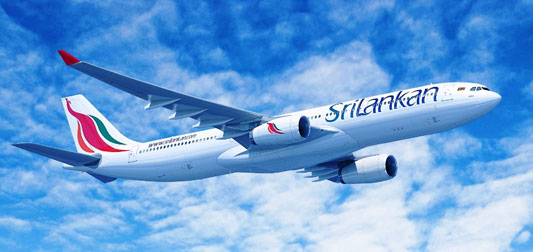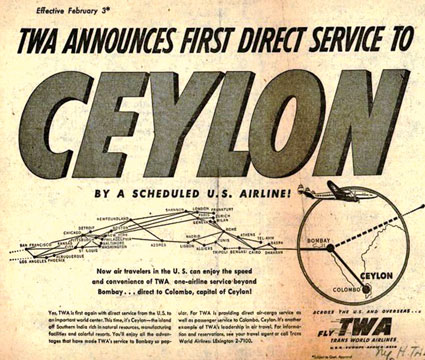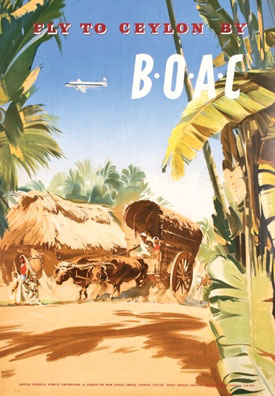A Century of Flying in Lanka Skies
by Kishani Samaraweera
Man has always wanted to emulate the birds. Flying was the ultimate
quest and hundreds had sacrificed their lives trying to find the secret
of flight. However, it remained the exclusive preserve of birds until
December 17, 1903 when "heavier than air" flight became a possibility.
The Wright Brothers flew a rudimentary plane for a few metres at Kitty
Hawk, North Carolina, USA, starting the modern era of aviation.
 In just 113 years, we have come a long way. Today's apex airliners
such as Airbus A380 and the Boeing 747-8 Continental are highly complex
machines, but they essentially rely on the same aerodynamic principles
used by the Wright Brothers' plane. In just 113 years, we have come a long way. Today's apex airliners
such as Airbus A380 and the Boeing 747-8 Continental are highly complex
machines, but they essentially rely on the same aerodynamic principles
used by the Wright Brothers' plane.
Located strategically between the East and the West, it was not long
before Ceylon (as Sri Lanka was known then) became a hub in the nascent
days of aviation. According to reports, the first plane arrived in Sri
Lanka on September 12, 1911.It was brought to the country for the use of
Colin Brown,an Englishman.
Built in France, the aircraft was the best flying machine during the
time. However it had been used for exhibition purposes when it was first
brought to the country.
In 1911 Franz Oster, a German pilot, who became the first pilot to
lift off in the skies of Sri Lanka brought a monoplane named, Etrich
Taube. In the first attempt, he managed to reach a height of 40 feet.
However it crashed and he sustained minor injuries. And he was
successful in his second and third attempts as well.
On December 7, 1912 Georges Verminck and Marc Pourpre were able to
fly a Bleriot aircraft at Colombo Race Course grounds and land safely
which is now considered as the First Successful Flight in the skies of
Sri Lanka.
Air Ceylon
With aviation booming post-World War II, it was felt that Ceylon
should have an airline of its own. Hence the birth of Air Ceylon. Having
achieved the title as one of the safest airlines, Air Ceylon did not
have any passenger fatality during its 32-year history.
However on December21, 1949, an Air Ceylon Douglas C-47 Dakota faced
an accident in which the aircraft was damaged beyond repair. At the time
the aircraft was carrying 21 passengers and three crew members who
survived the accident.
Australian National Airways (ANA), KLM Royal Dutch Airlines (the
oldest airline still in existence, it will resume flights to Colombo on
November 1), British Overseas Airways Corporation (BOAC) and French
airline UTA entered into partnerships with Air Ceylon. Air Ceylon was
shut down in 1978 to pave the way for Air Lanka, which reflected the
change in the country's name.
Air Lanka
Set up in July 1979, Air Lanka operated with two Boeing 707 jets on
lease from Singapore Airlines which were later bought by Air Lanka. The
number of destinations of Air Lanka was increased during the 1980s.
 Speaking to the Sunday Observer Civil Aviation Authority of Sri
Lanka's Director General of Civil Aviation, H.M.C. Nimalsiri said: Speaking to the Sunday Observer Civil Aviation Authority of Sri
Lanka's Director General of Civil Aviation, H.M.C. Nimalsiri said:
"During the mid-1980s the airline operated two Boeing 747-200
aircraft to a number of European destinations. The airline's golden
aircraft was the Lockheed L1011 Tri-Star, which served the airline from
1980 to 2000." (Lockheed was later bought by Boeing and Tri-Stars have
now been phased out of service worldwide).
In 1998,a ten-year strategic partnership was signed between Air Lanka
and Emirates where Air Lanka was "part-privatized" and the name was
changed to SriLankan Airlines.
"Emirates bought a 40% stake, which it later increased to 43.6%, in
Air Lanka, and sought to refurbish the airline's image and fleet. The
Government retained a majority stake in the airline, but gave full
control to Emirates for investment and management decisions," Nimalsiri
added.
Sri Lankan Airlines
Sri Lankan Airlines was launched when Air Lanka was rebranded in
1998. It was the first airline in Asia to induct fly-by-wire state of
art Airbus A320 aircraft.
The airline, now a part of the oneworld airline alliance, has six
Airbus A330-200s and A320-200 aircraft.
The A330-200 aircraft joined the airline between October 1999 and
July 2000. The airline has now retired its Airbus A340 fleet which
averaged 20 years or more.
According to the Director General of Civil Aviation in 2008 the
contract between Emirates and Sri Lankan government expired and later
Emirates had sold its shares for US$ 53 million in 2010 to the
government of Sri Lanka.
 The debt-hit loss-making airline is now looking for a strategic
partner to revive it and several Airbus A350 planes ordered previously
will no longer be purchased by the airline. The debt-hit loss-making airline is now looking for a strategic
partner to revive it and several Airbus A350 planes ordered previously
will no longer be purchased by the airline.
Incorporated on 27 October 2006 as a "low-fare airline", Mihin Lanka
is wholly owned by government of Sri Lanka. It started operations on
April24 2007. It has three Airbus aircraft and operates to a number of
destinations not served by SriLankan.
"The airline operates scheduled flights from its hub at Bandaranaike
International Airport to a number of cities in the Indian subcontinent,
the Gulf States and Southeast Asia.It code-shares with its partner Sri
Lankan Airlines on several routes, as part of a consolidation exercise
between the two airlines," said Nimalsiri.
The two airlines are likely to merge by next year, with SriLankan
taking over the routes now served by Mihin such as Mahe, Jakarta and
Bahrain.
In collaboration with JICA, the Government is also developing the
Bandaranaike International Airport (BIA) while trying to attract
airlines to the underserved Mattala RajapaksaInternational Airport in
Hambantota. BIA will be able to serve around 20 million passengers per
year and handle aircraft such as the Airbus A380 when the expansion
project is completed in a few years. These are exciting times for the
aviation industry in Sri Lanka.
Transformation
Sri Lankan Airlines First Officer Nuwan Gunaratne who is flying for
Sri Lankan Airlines for over six years says a lot has changed in the
field of aviation since he first started off as a pilot.
"A lot of things have improved and improved for good," he said.
 Elaborating on how it has evolved through time he says with the
introduction of budget airlines, the passengers now have a choice as to
which airline to choose according to the amount of money they wish to
spend. Elaborating on how it has evolved through time he says with the
introduction of budget airlines, the passengers now have a choice as to
which airline to choose according to the amount of money they wish to
spend.
"The primary goal of these budget airlines is to go from one
destination to another in the cheapest manner possible. So when you
compare today's situation with 10-15 years ago, the changes are good for
the passengers," he added.
Speaking about how the technology has developed especially with
regard to passenger aircraft he says that a lot of advanced facilities
are being introduced for the passengers.
"For example modern planes have flat bed in business class where you
can make the seat into a bed, in flight showers, bars, selection of
meals, own personalized suites."
Gunaratne also stressed the fact that with development, the time
taken to reach a particular destination and efficiency hasalso improved.
"Now we fly higher and faster, reducing the emissions as well as the
time," he added.
A dream come true
"It was my childhood dream to become a pilot," says Gunaratne.
Explaining how lucky he is to make his dream a reality, he mentioned
that he is extremely happy about the decision he took to take up
pilotingas a career.
"Every day I fly, the work environment is different and I fly with a
different person as my colleague to a different destination with a
different crew in different weather conditions with a different
aircraft. It has never been boring," he said.
Shamilka Fernando who is studying Mechatronics Engineering at the
Asian Institute of Technology(AIT) who is an aviation enthusiast says
from the very small days he was fascinated with aircraft and was curious
about it." I started my own research on airplanes when I was really
young," he says.
Shamilka has had his first flight when he was just three months old.
And since his father was abroad working for a major carrier in the
Middle East, during school holidays they visited him frequently.
 Recalling the first time he got the opportunity to go to a cockpit he
says that he was so excited and fascinated about the things he saw." The
pilot talked to me and asked what my ambition was. I simply said I want
to become a pilot. From that day onwards I learnt each and everything by
myself about airplanes," he added. Recalling the first time he got the opportunity to go to a cockpit he
says that he was so excited and fascinated about the things he saw." The
pilot talked to me and asked what my ambition was. I simply said I want
to become a pilot. From that day onwards I learnt each and everything by
myself about airplanes," he added.
Future
Expressing his views on the future of aviation, Gunaratne said that
room for improvement is huge but the only obstacle is financing such
facilities. However he also mentioned that with the Middle Eastern
airlines suchas Emirates and Qatar Airways keeping on adding more
services for passengers, other airlines will also have to keep up with
the latest trends.
" Safety wise there is continuous improvement. It will keep on
improving. Hybrid technology will also be added in future. For example
Airbus is designing an aircraft which uses your own body heat to
generate electricity for your in seat power supply," he added.
The book, "A Centenary Sky" by Captain Elmo Jayawardena, is a tribute
to the hundred year celebration of aviation in Sri Lanka."
The future is full of promises. There is no question about that. The
projected increase in tourist arrivals alone will keep the Centenary Sky
very busy. New airlines are looking for slots to fly to Sri Lanka.
Domestic destinations and charter operations are becoming popular,
adding more planes to the Centenary Sky."
"The aim is to move forward, erasing the mistakes made in the past
and working with dedication and determination to create a prosperous
aviation industry," he says. |

